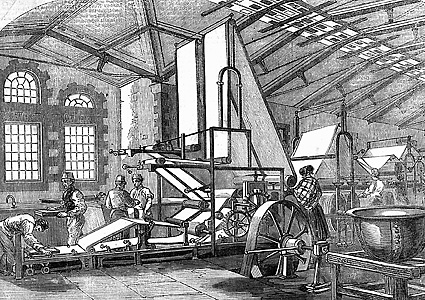Paper is one of our most important industrial products. Books, magazines, and newspapers are printed on paper. Data obtained from computers are often printed on paper. Education, government, and industry could not operate without printing and writing papers. Other important paper products include paperboard, which is used in packaging, and absorbent papers, such as tissue and toweling.
World production of paper and paperboard totals about 450 million tons (410 million metric tons) each year. China and the United States are the leading paper-producing countries. Chinese and U.S. mills combine to make about 45 percent of the world’s paper and paperboard.

Paper is made from cellulose fibers, which are found in all plant cell walls. When a mixture of water and fibers is filtered through a fine screen, the fibers tangle together to form a sheet of paper. As the wet sheet is dried, chemical bonds form between the molecules in cellulose fibers next to one another, giving the sheet of paper its strength. Papermaking fibers come from many different plant sources, including bamboo, cotton, esparto, hemp, jute, sugar cane, wheat and rice straws, and various woods. Wood is the major source of papermaking fibers in North America.
Paper manufacturers produce thousands of grades and types of paper. The properties of any paper depend on the fibers and processes used in making it.
How paper is made
Raw materials.
For centuries, the principal raw materials used in papermaking were cotton and linen fibers obtained from rags. Today, these fibers have been largely replaced by wood pulp. Pulp is the name used for fibers that have been prepared for papermaking. Wood used for papermaking is either harvested for this purpose or comes from lumber and woodworking wastes. Some cotton and linen fibers are still used for high-quality writing papers, business letterhead papers, art papers, and documents that will be kept for years.

Wood pulps are obtained from many kinds of wood, including aspen, beech, birch, fir, gum, hemlock, oak, pine, and spruce. The fibers used for papermaking were once living cells in the wood of the tree trunk. Fibers are thin, hollow tubes sealed at the ends, and are from 1/25 to 1/5 inch (1 to 5 millimeters) long. A substance called lignin holds the fibers together.
Waste paper is sometimes recycled to make new paper. Large tanks called pulpers convert newspapers, magazines, and other printed wastes into usable pulp. Ink is removed from the paper through use of solvents and other chemicals, detergents, and special cleaning methods. Recycled fiber is sometimes called secondary fiber. Manufacturers use secondary fiber to make paperboard, some printed papers, paper napkins, and toweling.
Pulping processes.
There are three different kinds of pulping processes used to convert wood into pulp. They are (1) mechanical processes, (2) chemical processes, and (3) semichemical processes. Semichemical processes combine chemical and mechanical methods.
The oldest mechanical process is the stone groundwood process, in which short logs are forced against a specially prepared grindstone. Friction heats the wood and causes the lignin between the fibers to soften. The grindstone then can easily grind fibers from the wood’s surface. In thermo-mechanical pulping, wood chips are preheated and fed between the rapidly rotating disks of a machine called a refiner. The mechanical action of the disks breaks the heated wood into individual fibers.
In chemical pulping processes, chemicals dissolve the lignin between the wood fibers. First, the wood is washed and cut into chips 1/2 to 1 inch (12.5 to 25 millimeters) long. In the sulfite chemical process, the wood chips are cooked in an acid solution in a steam-heated pressure tank called a digester. In the Kraft process, also called the sulfate process, chips are cooked in a solution of sodium hydroxide (also called caustic soda, or lye) and sodium sulfide. The cooking can be done in a batch digester or in a large tower called a continuous digester.
Semichemical processes use chemicals to soften the lignin. Disk refiners then mechanically separate the fibers from one another.
Pulps produced by any of the processes are washed and then passed through a series of screens to remove knots, debris, and other foreign material. Some pulps may be bleached to produce a whiter sheet of paper.
Refining.
In refining, the pulp passes between the rotating plates of a disk refiner. The mechanical action of the refiner unravels the fiber cell wall, making the fibers more flexible. The amount of refining the pulp receives determines the quality of the paper.
Sheet formation.
At one time, all paper was made by hand, one sheet at a time. Today, a papermaking machine can make a continuous sheet of paper up to 33 feet (10 meters) wide, at speeds faster than 5,600 feet (1,700 meters) per minute. Some papermaking machines are more than 350 feet (110 meters) long. Among the most common machines are Fourdrinier papermaking machines.

In a Fourdrinier machine, a device called a headbox spreads a mixture of water and fibers across the wire, a continuously moving plastic screen. As the wire moves along the Fourdrinier machine, water drains off, leaving a mat of fibers on the surface of the wire. Suction devices help to drain the water through the wire. When the mat is about one-fifth fiber and four-fifths water, the sheet has enough strength to be removed from the wire. The sheet then passes between large press rolls that squeeze water from the sheet until it is about one-half fiber and one-half water. Most of the remaining water is removed as the sheet passes over steam-heated cylinders. Chemical bonds that hold the finished sheet together form during this drying process.
The dried sheet may be smoothed by pressing it between the cylinders of a calender stack. It is then wound into giant rolls at the reel, and shipped to manufacturing plants to be made into finished products.
Twin-wire machines are similar to Fourdrinier machines, except that the sheet is formed between two moving screens. This enables the papermaker to remove water from both sides of the sheet.
A cylinder machine is used to make heavy paper and paperboard. A wire-covered cylinder, called a mold, is partially immersed and rotated in a vat of water and fibers. The sheet forms on the cylinder as water passes through the screen covering. The wet sheet is removed from the mold by a moving fabric belt called a felt. Several sheets of fibers can be layered on a single felt to form a multilayer paperboard. Sheets formed on cylinder machines are pressed and dried before they are wound at a reel.
Special kinds of paper
The properties of paper depend on various factors. These factors include the type of pulp used, the amount of refining done on the pulp, and the kind of papermaking machine used. Special additives, as well as treatments given to the paper during or after its manufacture, also affect the finished product.
Newsprint is usually made from thermo-mechanical pulp, or from a blend of one part chemical pulp for strength and three parts groundwood pulp for low cost and good printing properties. Many writing and printing papers are sized to prevent inks from spreading into the paper. Sizing is done either by including certain chemicals in the sheet or by coating the surface of the sheet with a starch solution. Dyes that bind to the pulp fibers produce colored papers. Many magazine and book papers are coated with a mixture of starch solution and clay. The coating becomes glossy when the paper is polished between the rolls of a super-calender. Paper treated in this way is especially good for printing.
Inexpensive writing papers are made from mechanical pulps. Higher-quality writing papers use blends of bleached chemical pulps. Rag pulps produce the finest writing papers. Many writing and document papers are watermarked by pressing a wire pattern into the top surface of the wet sheet while it is still on the Fourdrinier wire (see Watermark).
Toweling and napkins are made from recycled fibers or from blends of sulfite and mechanical pulps. Papermakers use special additives to give these products strength when wet. Most bag papers are made from well-refined, unbleached Kraft pulps. Bleached Kraft pulps are used for food packaging. Bleached Kraft paperboard may be coated with wax or plastic for milk cartons and paper cups. Cereal boxes and other cartons, tablet backs, and posterboards are made on cylinder machines from recycled newsprint.
Other products
Pulping processes produce a number of useful by-products. For example, used Kraft pulping chemicals can be treated to recover turpentine and tall oil, a raw material in paints and plastics. Imitation vanilla extract and alcohol can be made from used sulfite cooking solutions.
Some wood pulps are made for purposes other than papermaking. For example, mechanical and sulfite pulps serve as absorbent wadding in sanitary products and diapers. Manufacturers use pure sulfite pulps as raw materials for rayon and cellophane.
History
Paper gets its name from papyrus, a reed that the ancient Egyptians used for making a writing material. The Egyptians cut papyrus stalks into thin strips and pressed crisscrossed layers of strips into sheets.

Paper as we know it was invented in China more than 2,000 years ago. At first, the Chinese used the hemp plant or the inner bark of the mulberry tree for fiber. Later, they found that good papermaking fibers could be obtained by pounding rags, rope, or old fishing nets into a pulp. Early Chinese paper was too coarse for use in writing. The Chinese used it for wrapping and clothing.
The Chinese art of papermaking spread to other parts of the world after several Chinese papermakers were captured by Arabs in what is now Western Turkestan. The Arabs urged the papermakers to continue their art and teach it to the Moors in the city of Samarqand. The paper industry was established in Baghdad in A.D. 795. Papermaking spread to Europe as a result of the Crusades and the Moorish conquest of northern Africa and Spain. The first papermill in America was established near Philadelphia in 1690.
In 1798, a Frenchman named Nicholas Louis Robert invented a machine to make paper in continuous rolls rather than sheets. The Fourdrinier brothers, who were English merchants, financed improvements in this machine in 1803. The first American Fourdrinier machine was built in 1827.
The stone groundwood method for making wood pulp was developed in Germany in 1840. In 1854, the first chemically produced wood pulp was made in England. During the 1850’s, the American chemist Benjamin C. Tilghman found that the fibers in wood could be separated by treating them with sulfurous acid. By 1882, much of the wood pulp used was made by this process.
In 1883, a German inventor named Carl Dahl discovered that adding sodium sulfate to the soda process produced a very strong pulp. This discovery produced the Kraft process. Kraft means strength in German. During the early 1900’s, the Kraft process became the most important pulping process, and the Fourdrinier machine became the primary device for making paper.
Significant improvements in papermaking since the mid-1900’s include thermomechanical pulping, synthetic wires and felts, twin-wire machines, and the use of computers to control pulping and papermaking operations. Paper manufacturers have also worked to improve pollution control and energy conservation in the industry.
